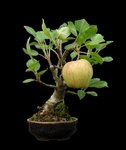Culinary apples, or "normal form" of apples can be used for bonsai. They have been used for bonsai. The only issue of note is the size of the fruit does not reduce. In general, for the vast majority of tree species, fruit and flowers do not reduce with bonsai techniques. The leaves will reduce nicely, but flowers and fruit will not. In general, large flowers are not usually viewed as a negative, so you will see almost no complaints about flowers being too large. *note: the exception is those who take the deep dive into the Satsuki azalea dungeon, those lunatics will complain about flower size.
With your apple, when it does get around to flowering, do not let too many fruit develop. The production of fruit takes a metabolic priority, and it is possible to exhaust a tree by allowing too many fruits to develop. And when the fruit develops, you are right, you might have to construct supports to keep the weight of the fruit from tearing the branch off the trunk.
Apples from seed, be aware, often apple seedlings to not get around to flowering for the first time for 10 to 20 years. Out of every batch of 100 or more seedlings, a small number will flower early, as soon as 5 years or so. The majority will begin flowering between 10 and 15 years, and a significant few will not get around to flowering until well over 20 years old. But during this time, you can develop a kick ass tree.
Once an apple begins flowering, it will flower every year, it is just a matter of running the "genetic clock" out to get the tree through the transition into mature growth.
Note, cuttings, air layers, and grafted scions from trees that are already mature enough to be flowering and producing fruit will continue to do so, as soon as the cutting, or air layer or scion is metabolically healthy enough to produce flower buds. Usually less than 5 years for a cutting.
Malus sieboldiana - Toringo Crab apple, at the National Bonsai Collection, Washington DC. Note the beautiful sense of proportion, the fruit are in scale with the tree.
View attachment 291581
Here are two culinary size apples, note how out of scale the fruit is. Okay if you are going for shock value, but no sense of proportion.
View attachment 291579
View attachment 291580







